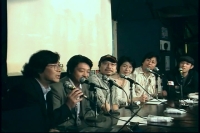 |
 |
|||||||||||||
|
|||||||||||||
|
|||||||||||||
|
Men and women wearing gaudy dresses, looking for customers under garish neon signs – this is a common sight in Kabuki-cho, Shinjuku, a famous entertainment and red-light district in Tokyo, Japan. Walking down an alleyway that has countless bars and nightclubs, you will see a hand-written sign posted on the billboard of a shabby building that says, “The Accelerator’s Night 3.” This sleepless town is home to the “Accelerator's Night,” the science seminar produced by Kenichi Kojima, who organises group tours to such places as laboratories, factories, or historic places called 'Shakai-ka Kengaku ni Ikou!' (Translation: Let's go on a field trip!). With nearly 7000 registered members already, people who want to join this touring community can register online for free. Members must be over the age of 20 though, creating a unique sort of field trip club for adults only. Kojima first visited KEK two years ago as a destination on one of his field trips. He had never seen any accelerator until that visit, and he found it amazing and very interesting. Ever since, KEK has become a regular spot for their field trips. Kojima recalls one trip when the chartered buses from Tokyo station to KEK got stuck in a traffic jam. Satoru Yamashita of the International Center for Elementary Particle Physics, University of Tokyo, who was attending the trip, tried to kill the time while stuck on the bus by talking about accelerator science, particle physics, and the International Linear Collider for two full hours. “People on the bus enjoyed his talk very much, so I proposed that Dr. Yamashita have a seminar with his colleagues,” he says. As a result, Kojima then arranged the “Accelerator's Night” at the night club owned by his friend in Kabuki-cho. “When I heard about a plan of this seminar, I was very doubtful that we would have any audience. Surprisingly, the place was packed,” says Yamashita. “I was amazed to find that so many people are interested in accelerator science. They are not only interested in the science but also fascinated by the machine itself. That really opened my eyes.” Aya Kaida, novelist and one of the enthusiastic members of the community, was one of the moderators of the seminar and admittedly under a spell of accelerators. “The accelerators are such beautiful machines. I don't think scientists are aware of that very much. It is a shame to not show these beauties to more and more people,” she says. The small night club located on the basement floor of the gloomy building was crowded with about 70 attendees, who came from various fields. Of course there are some engineers or college students with physics backgrounds, but most of them don't have any direct connection to the particle physics at all. Also, there were many women in the room, which is a very unusual sight in Japan. “People gathering here are very active in so many ways. It is very import for us to introduce our effort to the people like them. A new project like the ILC especially needs more attention and understanding from the general public,” says Junpei Fujimoto, a KEK scientist and one of the lecturers. He believes that seminars like this will help increase the understanding of global efforts like the ILC. “The topics of the seminar are very general, but we would like to talk about more technical and scientific subjects in the future. Hopefully, we can have seminars like this regularly in different cities,” he says. Scientists are getting valuable feedback from the audience. Yamashita thinks this seminar serves as a good exercise for scientists to talk to people outside the particle phisics community. “We are learning so much from the audiences, such as where their interests lay, and how we should attempt to gain more understanding,” he says. Followed by the brisk question-and-answer session, the seminar finally ended well over one hour after the scheduled agenda, making the scientists run at their top speed toward Shinjuku station to catch the last train home. Kojima is planning to have another field trip to KEK in August and a fourth seminar in November. “I definitely would like to arrange a field trip to tour to ILC when it is built, and if possible, I want to see its construction. I am looking forward to seeing the ILC realised,” he says. Thanks to innovative thinkers like Kojima, Japanese scientists are succeeding to gain ILC supporters surely and steadily. -- Rika Takahashi |
|||||||||||||
| © International Linear Collider |
